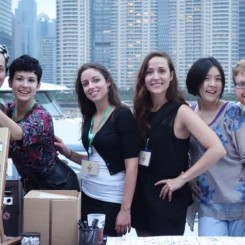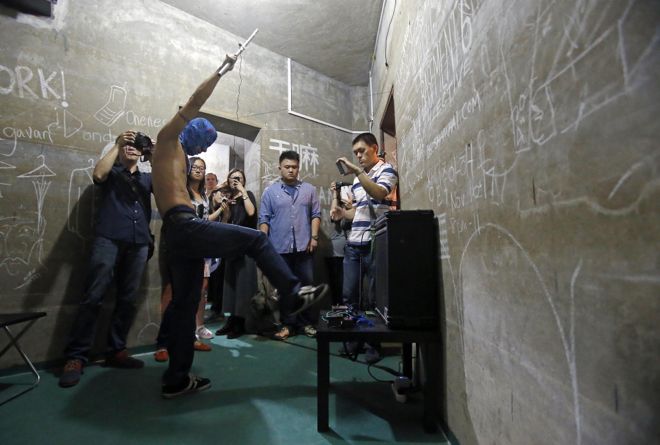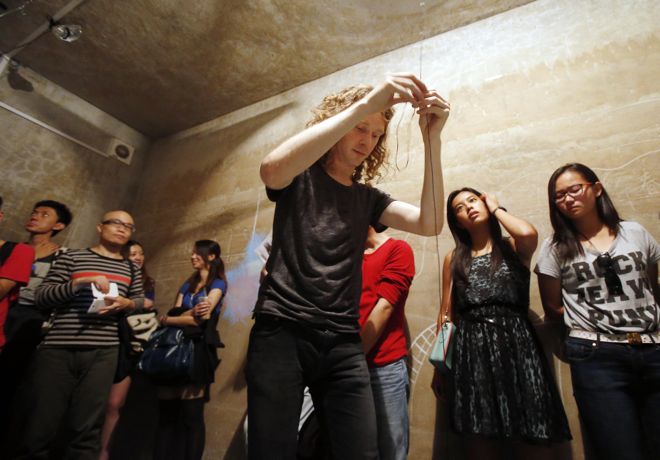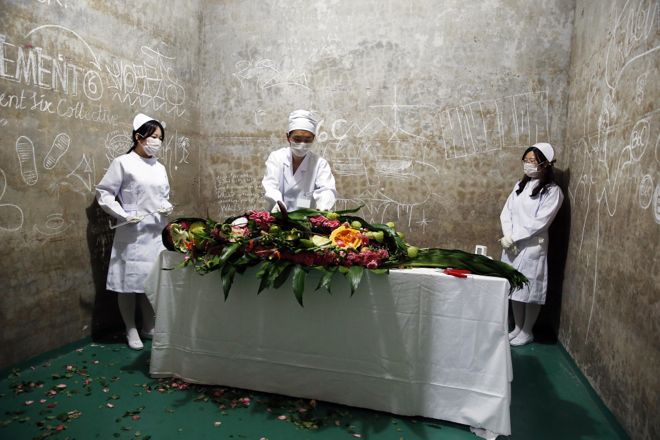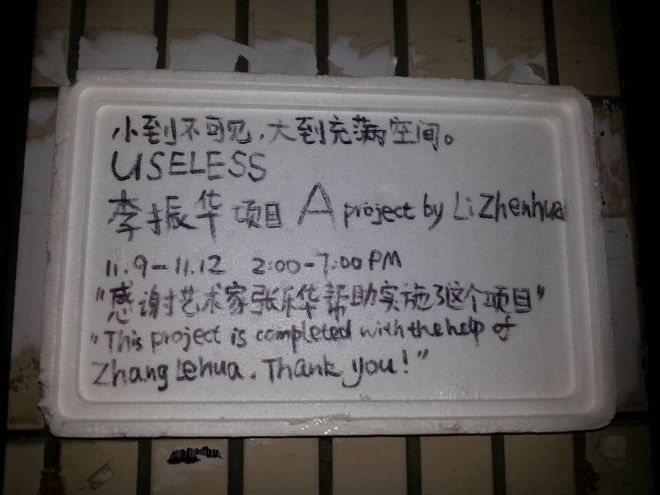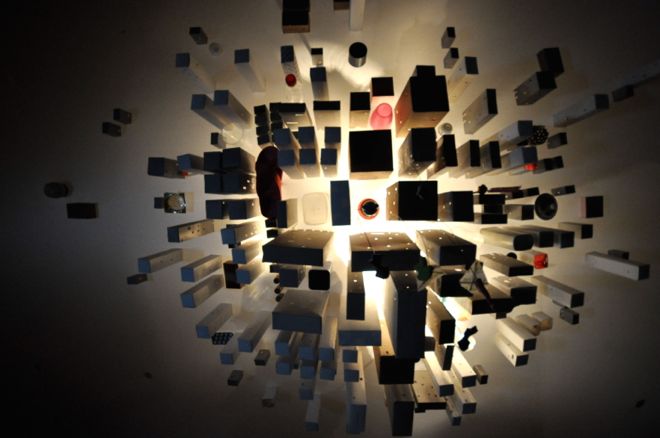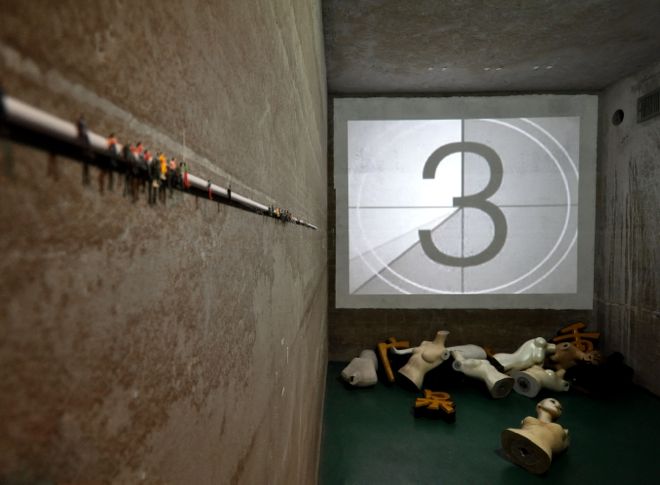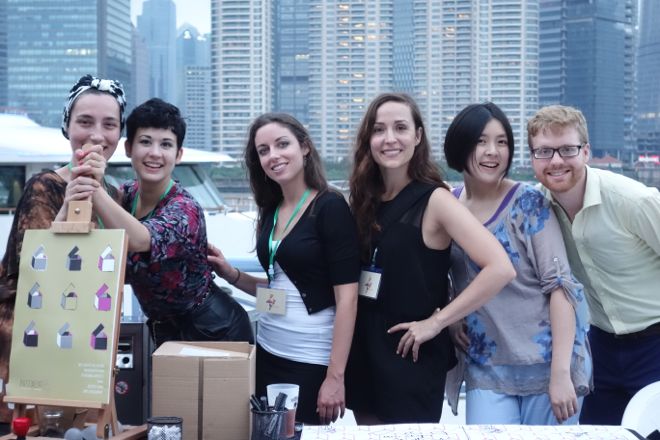The cramped, labyrinthine tunnels of the Number 6 Basement of the compound at 2006 Huashan Lu in Shanghai witness an eclectica of scenes. Dancers in the dark and dimly lit drinks constitute its standard fare, as does the even more surreal. One Sunday last fall, that took the form of Junky Cao, a Shanghainese sound artist, his scrawny torso stripped bare and his face concealed behind a Mexican wrestling mask, working some odd dials to produce discordant noise, tossing himself about to the cacophony. In the backmost room, the lab coated Moyo performed a slow, meticulous autopsy of…a flower arrangement. Later, the experimental dancer Xiao Ke took the floor, literally—thrashing and lurching on the grotty green ground.
The performances, “Stacked Room” and “We forgot to tell you there is a date this afternoon”, were part of the “Make Plus” art and technology festival, co-sponsored by V Art Center, the Xinchejian hacker space, and MoCA and Minsheng Art Museum. During the event, the basement’s rooms were then packed with mostly young Chinese, madly Weixin-ing the spectacles. Basement 6 Collective (B6C), a non-profit creative and experimental space that just commemorated its first anniversary, and though not consistently so collaborative in its organization or so broad in its audience, acts as a free-form laboratory of artistic ideas. Uncurated and unfiltered, it welcomes all comers, showcasing young and amateur artists while giving established talents a chance to risk something new. It also shows that, amidst the gentrification of Shanghai’s neighborhoods and the rarification that comes with the professionalization of its art scene, there still remain such dingy pockets of the unapologetically and delightfully weird.
Both the collective and the location came together in the spring of 2013, with Basement 6 debuting to the public with initial events in June, explained Sophia Lin, a Canadian-educated Shanghainese curator who focuses on technology and art. Katy Roseland, an American with a background in design and multimedia who has lived in China for four years recalled, “I wanted to find a place to work, and to do ‘No Lights No Lycra’, a dance freestyle with Anneliese [Charek], and we were looking for a venue that was open to the community but not a bar.” Roseland and Charek, a dancer and videographer from Los Angeles, met Lin via Craigslist, and “she suggested the idea of a collective…which could work here.”
The concept of an office and workspace also open to events congealed as the group expanded to eight. Arlene Fetiss, from Scotland, studied textile design and does illustration and camera obscura art. The collective is rounded out with four more young American artists: Kate Mimman, Rebecca Diaz, Megan Dodd, and Sean Kell—who also organizes storytelling events. “Seven of the eight of us are women. We work well together, and it just happened,” Roseland observed. However, there were some misdirects. “On Couchsurfing, we met this Italian, who wanted to squat here, and he was kind of adamant about it.”
“I love the collective, and the rest is really energetic. There is stuff you won’t see, only find it here,” said Lin. Li Zhenhua, a renowned curator (who also curated the Film sector of Art Basel Hong Kong, among other projects) and Zhang Lehua, an artist realized a found art project, “Useless”, in November last year, and Basement 6 is also are among the coordinators of the Dr. Sketchy’s “anti-art” drawing events at venues around town.
“I am really thankful for Basement 6,” said Wang Xin, who first met Lin through Xinchejian and has done two basement projects, “Into the Territory” and the hypnosis experiment “‘Extra -Dimensional’ Art Ecological Survey.” “The good thing about not having a curator is that you can try out your idea in the largest degree. Whether or not it can ultimately work, you can learn a lot during the process.”
“When they offered me the opportunity to expose B6C I thought that ‘Nonsense’ was perfect for this space because there I could build anything, [with] total creative freedom in a unique space,” recounted Stefano Ogliari Badessi. Badessi, an Italian resident previously at the Swatch Art Peace Hotel, is a founder of Little Victories Project, a gallery on a sanlunche industrial tricycle that frequently collaborates with Basement 6. For his Basement 6 show last September, “Nonsense”, he suspended a miniature, inverted cityscape from the basement’s ceilings. “I wanted to represent the feeling that you are trying to discover a great city, its charm and its lights, its contradictions, its mysterious sides and everything that strikes our fancy. These feelings are mixed, creating an urban project with no real logical sense, a sum of mixed memories in mind.”
For the concept, Badessi explained, “The curatorial directive that I received was to keep in mind that this is an experimental space in which it is imperative to experiment. These words in my mind turned into motivation and energy to put in the installation. The idea of being able to experiment and try new emotions is what an artist wants to use a space without limits is magnificent.” The space influenced the process as well. “To create the installation took me 24 hours over two days…Being locked in a fallout bunker with no relation to the outside world was alienating but very interesting at the same time because it allows you to focus a lot and lose yourself in the work you are creating.”
“The feeling is that the talented people we meet are excited to be working in a non-commercial space with the freedom to experiment in their own field. We will keep the space funded out of pocket and ran on our free time in our ‘art punk’ DIY spirit,” says Roseland. In June, every Thursday from 7 to 10 pm, Basement 6 hosts The Exchange Program (TEP), featuring twenty Chinese video artists to promote local video talent abroad, in a series of joint showings with international cities: Cannes, France is first up, for June. The line-up includes both big names and up-and-comers: Wang Fang, Xia Mu, Wang Xin, Li Ming, Cheng Ran, Li Xiao Fei, Xu Zhe, Chen Hangfeng, Qiu Anxiong, Wu Ding, Elian, Li Liao, Wu Chao, Mujin, Hu Qingtai, Ni Weihua, Liang Yue, Hsu Che-Yu, Ye Linghan, and Hsu Chia-Wei.
Those wanting to visit the Shanghai space might find it easier to visit Cannes. To reach Basement 6, one must veer into a nondescript compound of dingy residential towers, past a Dongbei restaurant and a fruit shop. The massive compound is undercrossed with such bomb shelters turned mostly storage spaces, and the beloved six-year-old music rehearsal and recording studio Juju. It also houses a brothel masked as a salon—which many Basement 6 first-timers erroneously discover. The winding, concrete steps down creep down next to an old conveyer belt—relics of industrial pasts. Grimy corridors twist and turn, past moldy, upended sofas and rusty, unloved bicycles, and a few dead ends and backtracks.
As does the audience, with predominately a range of young foreigners and younger Chinese, but a cross section rarely seen at gallery or museum events. Xia Mu assessed his opening as consisting of his friends, Shanghai-based artists, and residents of the local neighborhood, mostly curious and enthusiastic seniors. Said Roseland, “We have a good local/foreign level for events: English, Chinese, bilingual. Make Plus is very local, and Lycra gets Shanghainese into dancing, for the curious. And we get the Swatch affiliates, all around our age,” of late twenties and early thirties.
Basement 6 ranks among a small handful of experimental art non-profits now active in Shanghai, along with Little Victories and Bazaar Compatible, a space in the Anshun Road Small Goods Market. Lin added that frequent collaborator AM Space also hosts similar performance and installation events. Though it can lean towards the amateur and expatriate, Basement 6’s endeavors as young, experimental Chinese platform even evoke the early days of BizArt, out of which Shanghai’s current, now-commercialized scene largely emerged. Though at times overly protesting of their distance from the “official” art world, the unpolished, unprofessional nature of the collective’s activities are precisely what make it accessible—and important.
“We at Little Victories and B6C have in common the need to disseminate art, the deep desire to always give more importance to art and artists and art lovers to connect,” enthused Badessi. “It does not matter if the art is presented on a [shabby] bicycle or in a wet basement, it is important that it is quality art, that speaks to the public…you can feel that there is love and passion in everything; the goal is the art and not the money.”
There will be a special collaboration project / two person show of Chen Tianzhuo and Lu Yang on July 26, from afternoon to late evening.

